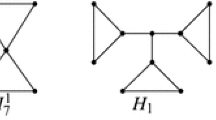Abstract
We say, that a subset K of the columns of a matrix is called a key, if every two rows that agree in the columns of K agree also in all columns of the matrix. A matrix represents a Sperner system K, if the system of minimal keys is exactly K. It is known, that such a representation always exists. In this paper we show, that the maximum of the minimum number of rows, that are needed to represent a Sperner system of only two element sets is 3(n/3+o(n)). We consider this problem for other classes of Sperner systems (e.g., for the class of trees, i.e. each minimal key has cardinality two, and the keys form a tree), too. The concept of keys plays an important role in database theory.
Similar content being viewed by others
References
S. Abiteboul, R. Hull and V. Vianu, Foundations of Databases (Addison-Wesley, Reading, MA, 1995).
W.W. Armstrong, Dependency structures of database relationship, in: Information Processing 74 (North-Holland, Amsterdam, 1974) pp. 580–583.
F.E. Bennett and L.S. Wu, On minimum matrix representation of closure operations, Discrete Appl. Math. 26 (1990) 25–40.
F.E. Bennett and L.S. Wu, Minimum matrix representation of Sperner-systems, Discrete Appl. Math. 81(1-3) (1998) 9–17.
J. Demetrovics, On the equivalence of candidate keys with Sperner systems, Acta Cybernet. 4 (1979) 247–252.
J. Demetrovics, Candidate keys and antichains, SIAM J. Algebraic Methods 1 (1980) 92.
J. Demetrovics, Z. Füredi and G.O.H. Katona, Minimum matrix representation of closure operations, Discrete Appl. Math. 11 (1985) 115–128.
J. Demetrovics and G.O.H. Katona, Extremal combinatorial problems in relational database, in: Fundamentals of Computation Theory 81, Proc. of the 1981 Internat. FCT Conference, Szeged, Hungary, Lecture Notes in Computer Science, Vol. 117 (Springer, Berlin, 1981) pp. 110–119.
Z. Füredi, The number of maximal independent sets in connected graphs, J. Graph Theory 11 (1987) 463–470.
Z. Füredi, Perfect error-correcting databases, Discrete Appl. Math. 28 (1990) 171–176.
B. Ganter and H.-D.O.F. Gronau, Two conjectures of Demetrovics, Füredi and Katona, concerning partitions, Combinatorics of ordered sets (Oberwolfach, 1988), Discrete Math. 88(2/3) (1991) 149–155.
J.R. Griggs, C.M. Grinstead and D.R. Guichard, The maximum number of maximal independent sets in a connected graph, Discrete Math. 68(2/3) (1988) 211–220.
M. Hujter and Z. Tuza, The number of maximal independent sets in triangle-free graphs, SIAM J. Discrete Math. 6(2) (1993) 284–288.
G.O.H. Katona, Combinatorial and algebraic results for database relations, in: Database Theory – ICDT '92, eds. J. Biskup and R. Hull, Berlin, Lecture Notes in Computer Science, Vol. 646 (Springer, Berlin, 1992) pp. 1–20.
J. Liu, Maximal independent sets in bipartite graphs, J. Graph Theory 17(4) (1993) 495–507.
H. Mannila and K. Räihä, The Design of Relational Databases (Addison-Wesley, Reading, MA, 1992).
R.E. Miller and D.E. Muller, A problem of maximum consistent subsets, IBM Research Report RC-240, J.T. Watson Research Center, Yorktown Heights, NY (1960).
J.W. Moon and L. Moser, On cliques in graphs, Israel J. Math. 3 (1965) 23–28.
B.E. Sagan, A note on independent sets in trees, SIAM J. Discrete Math. 1 (1988) 105–108.
K. Tichler, Minimum matrix representation of some key systems, Discrete Appl. Math. 117(1-3) (2002) 267–277.
H.S.Wilf, The number of maximal independent sets in a tree, SIAM J. Algebraic Discrete Methods 7 (1986) 125–130.
Author information
Authors and Affiliations
Rights and permissions
About this article
Cite this article
Tichler, K. Extremal Theorems for Databases. Annals of Mathematics and Artificial Intelligence 40, 165–182 (2004). https://doi.org/10.1023/A:1026162114022
Issue Date:
DOI: https://doi.org/10.1023/A:1026162114022



